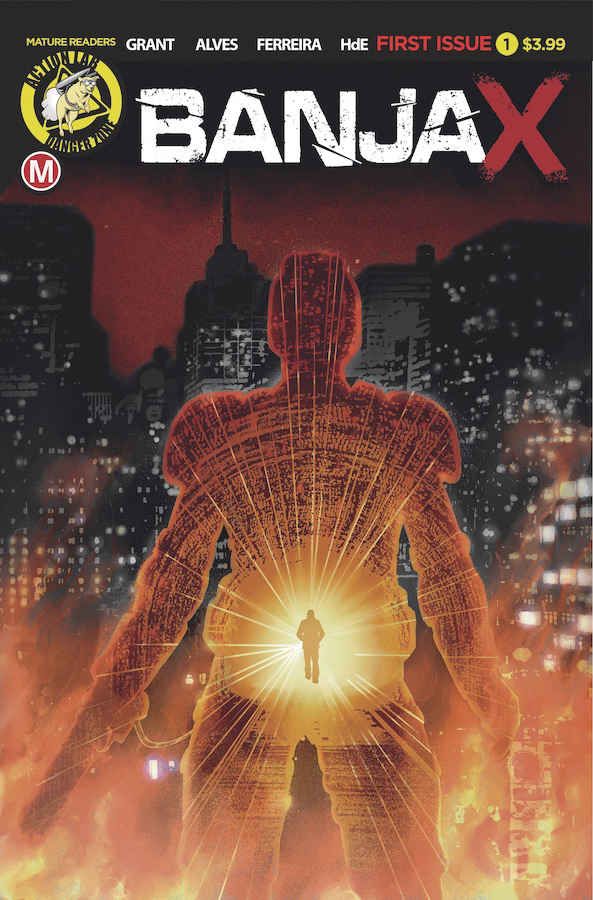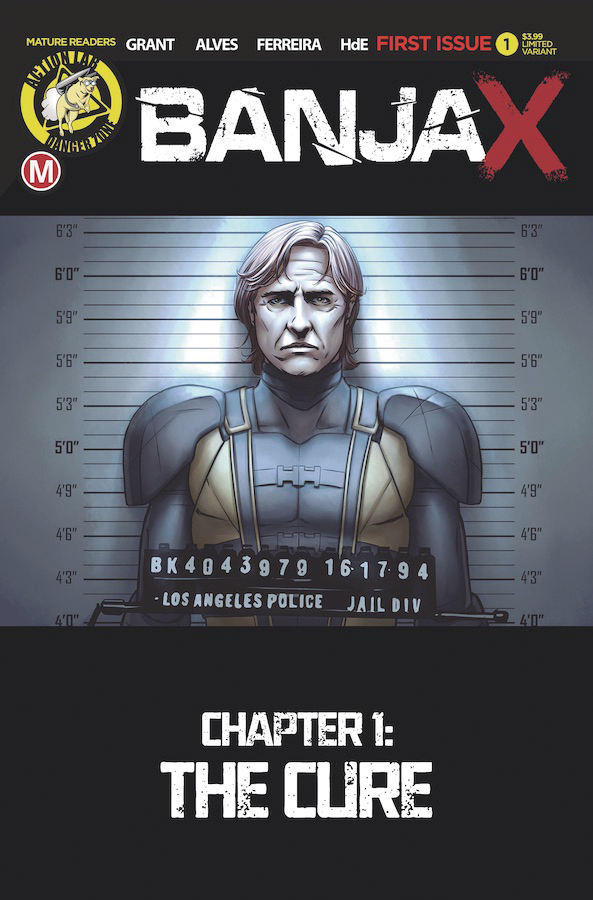Humiliated Hero Looks Back At Legacy in Action Lab's "Banjax"
Jun 10, 2019
Coming to you this June from Action Lab: Danger Zone is Banjax, a dark and decidedly wicked superhero noir that pulls no punches, that suffers no fools, that repeatedly gets knocked down, but always gets back up again with a smile.
Disgraced former superhero, Laird Mason, is diagnosed with terminal cancer brought on by years of using his powers. Defending what he has deemed an ungrateful and ultimately unworthy city is literally killing him. With just months to live and a legacy hanging in the balance, Mason launches a violent and misguided Death Wish-like campaign to purge the city of scumbags before he dies.
PREVIEWSworld.com talked to Banjax writer Rylend Grant about what to expect in the upcoming series.
Be sure to pick up Banjax #1 (APR191268) and the Banjax #1 variant (APR191269) at your local comic shop on June 12th!
**********
PREVIEWSworld: Banjax isn’t a traditional superhero narrative. Your protagonist, Laird Mason, is on a purge-like mission to rid the city of villains. What are his motives here?
Rylend Grant: For years, Laird Mason – a bare-knuckle-brawling, working man’s superhero know as BANJAX – gleefully stood between the people of Los Angeles and anyone or anything that meant them harm. He became a sort of folk hero, was universally loved, until he took things a step too far. One nasty night, Mason beat a serial rapist to half to death with cameras rolling/on national television. The public turned against him in the blink of an eye. He was ostracized, cut on trial, banned from ever donning the proverbial cape again… and he ended up in an emotional and existential tailspin.
Our book begins years later in a drug/alcohol rehab center where Mason is examined after a years-long bender and is diagnosed with terminal cancer brought on by years of using his powers. Defending what he has deemed an ungrateful and ultimately unworthy city is now literally killing him.
So, with just months to live, Mason takes a long look at and a legacy… at his beloved city that has, in his estimation, become something akin to a cesspool in his absence. He ultimately decides that he just can’t go out like that… and so he launches a violent and misguided Death Wish-like campaign to right things, to purge the city of scumbags before he dies.
PREVIEWSworld: Tell us about the title. Banjax means to destroy, or something that is an absolute mess. How does that relate to this story? What is Laird Mason getting himself into?
Rylend Grant: Well, Mason isn’t exactly ideal hero material. He’s a deeply flawed human being, wrestling with all sorts of psychological ugly. He’s the kind of guy – and we all know somebody like this – that just destroys (banjaxes) everything he touches… relationships, the lives of the people he loves. For a brief moment, however, he was able to channel all of that destructive energy and point it like a laser beam at those who meant to do harm. It was the only time his life made any sense, the only time he was ever worth a damn. The public, the media, the judicial system took that from him after “the incident” and his life went to hell. When he realizes here that he only has so much time left, he decides to harness that rage once again for what he believes is the greater good.
PREVIEWSworld: There’s a real Batman vibe to the story. From the bleakness of the city to the teaming up with a sidekick… What comics/movies/TV shows inspired you here?
Rylend Grant: Yeah. The Batman thing is dead on. I’ve always been attracted to those dark, noirish superhero stories. And there will most definitely be readers who flip through Banjax and just see a wildly twisted take Batman and Robin story. It’s almost impossible to avoid those comparisons. I mean, Batman is the gold superhero-and-a-sidekick standard, right? That dynamic is just ingrained in/imprinted upon our cultural subconscious at this point. Really, what I’m doing here, though, is trying to use that against the reader. I know exactly what he/she expects to get out of a Batman story, what he/she will assume is around the next corner. Banjax is really a puckish exercise in subverting those expectations, in zigging when the reader is sure you’re going to zag.
Batman tends to drift into the lane of the fantastic, the gothic, the operatic… Banjax is much more grounded and raw. It is an almost morbidly realistic look at what would actually happen if there were folks in our world running around with superpowers. It’d certainly be the wrong people – remarkably flawed people with a ton of baggage – that would end up with powers. The fame, the money, the ability to influence that came with heroing would almost be debilitating. Let’s just be honest… if you or I woke up with powers tomorrow, we’d never be that point-and-wink superhero ideal. We’d be total jerks. I mean, we might not go so far as to break supervillain, but we’d definitely just do whatever the heck we wanted... It’d get ugly fast.
Banjax isn’t a black and white story. There aren’t really good guys and bad guys here. Everyone exists as some (usually very dark) shade of gray. A close comic creator friend recently compared Banjax to the FX series The Shield. I thought it was pretty dead on in a way. In both Banjax and The Shield, you root for these characters that are doing really awful things because they truly believe it’s for the greater good. You’re also often rooting against folks that are doing the right and lawful thing because it is sometimes the WORST thing you can do in a situation… We don’t see that sort of wicked dichotomy play out often enough in comics or on television. It’s a shame too, because it makes for a really fun ride.
To cut right to the heart of your question though… my influences… In pitching Banjax to publishers, I somewhat pretentiously described it as a dripping-with-character Paul Thomas Anderson-like addiction play folded into a Tony Gilroy-penned action noir, directed by Michael Mann… Now, tell me that doesn’t sound intriguing.
PREVIEWSworld: You have a ton of experience from the world of film. How does your experience impact the way this story moves?
Rylend Grant: Yeah. I‘ve spent the last decade or so writing film and television projects – mostly poppy action fair – for folks like JJ Abrams, Ridley Scott, Justin Lin, F. Gary Gray, John Woo, and Luc Besson… and you’ll definitely see some of that Hollywood thriller DNA in Banjax.
Comics is a visual medium, obviously. I have a degree in film directing from the American Film Institute Conservatory (where David Lynch and Darren Aronofsky went), so I treat each issue like a little film I’m directing. I actually went so far as to give myself a writer/director credit on Banjax. At the risk of my metaphor becoming a metafive, I’ll say that I kind of see my artist (Fabio Alves), Colorist (Edson Ferreira), and letterer (HdE) as my cinematographer, production designer, and editor. I think, if you approach things this way, you end up with a very filmic book in the end, something that authentically feels like a good movie or TV show. That was certainly the reaction I got to my first comic series – Aberrant (also from Action Lab: Danger Zone – Season 2 hits comic shops in May) – and probably the main reason we got it set up so quickly in Hollywood as a TV series.
PREVIEWSworld: You’re taking a ton of risks with the way this narrative unfolds by changing point of views every issue, unreliable narrators and so on. How do you look to reward the reader with these techniques? What’s the payoff?
Rylend Grant: Well, a few years ago, my writing – I’m specifically talking about my film/TV writing here – got really stale. You are so limited in what you can do in Hollywood right now. They basically only make three or four different kinds of movies these days… and they expect you, as the screenwriter, to execute those movies in a very specific way. Well, I got pretty damn good at mailing those movies in. It’s how I bought my house. But man, did I get bored quick.
The beauty of the comics business is there are, for the most part, very few rules and expectations. You can do most anything and everything, as long as it is entertaining and is executed well. When I finally decided to dive into the deep end of the comics pond (it had been a dream for a long time), I made a promise to myself that I was never going to tell a straight forward story, that I’d embrace experimental story telling elements… play with time, POV, some of the things you’re talking about.
Issue 2 of Banjax is told from the point of view of a man whom is literally being driven mad because he hasn’t slept in seven days. He’s starting to see things. Action figures and statues start to talk to him. He (and we, the reader) has no idea what’s real and what isn’t. It’s an absolutely bonkers ride.
The reward for the reader? Well, I can promise you that you’ll never know what’s around the next corner with Banjax. And how many books can you really say that about? When you work full time as a writer for a decade, story structure just becomes ingrained. You immediately see the patterns in any media you’re consuming, immediately know where things are headed. I piss my wife off all the time because I know eight minutes into a Top Chef episode (GREAT show BTW) who’s winning and who’s going home… your average comic reader today isn’t far behind me in that respect. They are wicked smart and well read and so the bar is set extremely high. You have to give that reader a reason to care, a reason to tune in next month… you have to give them something they haven’t seen before and that isn’t remotely easy with all the books out there these days.
The reward for me was immeasurable. Approaching comics in this way saved me/re-invigorated me as a writer. It made me excited to sit down at the keyboard again. And now – old school Producers be-damned – a lot of this experimental stuff is starting to kick it’s way into my film scripts… and the Hollywood-types really seem to be digging it. Maybe I didn’t give those guys enough credit, huh?
PREVIEWSworld: What can readers expect to see as this story unfolds? Where do the two protagonists go from here?
Rylend Grant: Well, Mason starts off trying to make the city a better place… but he makes compromise after ugly compromise and quickly ends up descending into full supervillain territory himself.
When things start to get look horrible, Abel Raines (Mason’s former sidekick, definitely the public’s current point-and-wink superhero ideal), is tasked with bringing his old mentor in. The issue? Raines isn’t remotely up it. Years of basking in the fame and business opportunity that comes with superheroing have made him soft, scared.
Mason is a guy with nothing to lose. Raines is a guy with everything to lose. A situation like that is fertile ground for drama.






